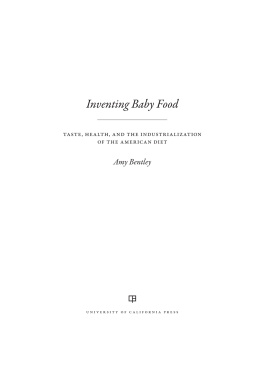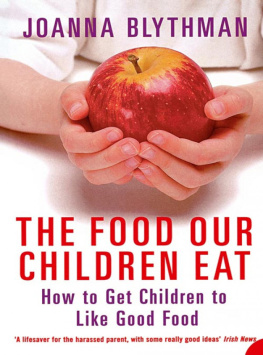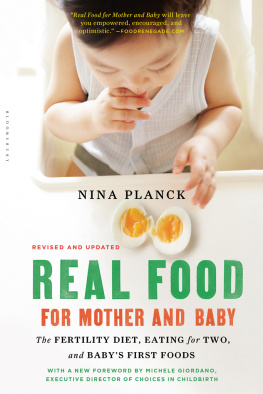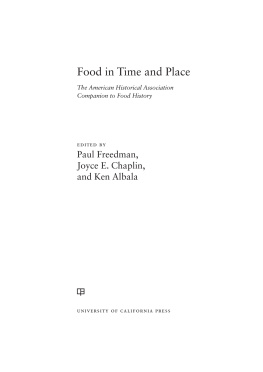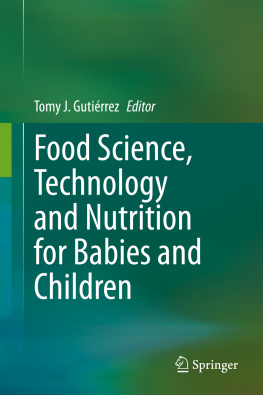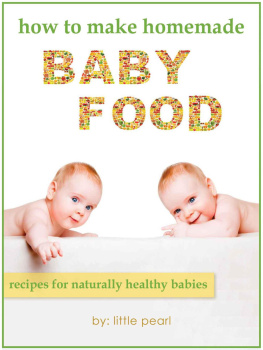Bentley - Inventing baby food: taste, health, and the industrialization of the American diet
Here you can read online Bentley - Inventing baby food: taste, health, and the industrialization of the American diet full text of the book (entire story) in english for free. Download pdf and epub, get meaning, cover and reviews about this ebook. City: United States, year: 2015, publisher: University of California Press, genre: Children. Description of the work, (preface) as well as reviews are available. Best literature library LitArk.com created for fans of good reading and offers a wide selection of genres:
Romance novel
Science fiction
Adventure
Detective
Science
History
Home and family
Prose
Art
Politics
Computer
Non-fiction
Religion
Business
Children
Humor
Choose a favorite category and find really read worthwhile books. Enjoy immersion in the world of imagination, feel the emotions of the characters or learn something new for yourself, make an fascinating discovery.
Inventing baby food: taste, health, and the industrialization of the American diet: summary, description and annotation
We offer to read an annotation, description, summary or preface (depends on what the author of the book "Inventing baby food: taste, health, and the industrialization of the American diet" wrote himself). If you haven't found the necessary information about the book — write in the comments, we will try to find it.
Bentley: author's other books
Who wrote Inventing baby food: taste, health, and the industrialization of the American diet? Find out the surname, the name of the author of the book and a list of all author's works by series.
Inventing baby food: taste, health, and the industrialization of the American diet — read online for free the complete book (whole text) full work
Below is the text of the book, divided by pages. System saving the place of the last page read, allows you to conveniently read the book "Inventing baby food: taste, health, and the industrialization of the American diet" online for free, without having to search again every time where you left off. Put a bookmark, and you can go to the page where you finished reading at any time.
Font size:
Interval:
Bookmark:

The publisher gratefully acknowledges the generous support of the Ahmanson Foundation Humanities Endowment Fund of the University of California Press Foundation.
Darra Goldstein, Editor
Amy Bentley

UNIVERSITY OF CALIFORNIA PRESS
University of California Press, one of the most distinguished university presses in the United States, enriches lives around the world by advancing scholarship in the humanities, social sciences, and natural sciences. Its activities are supported by the UC Press Foundation and by philanthropic contributions from individuals and institutions. For more information, visit www.ucpress.edu.
University of California Press
Oakland, California
2014 by Amy Bentley
Library of Congress Cataloging-in-Publication Data
Bentley, Amy, 1962
Inventing baby food : taste, health, and the industrialization of the American diet / Amy Bentley.
pages cm.(California studies in food and culture; 51)
Includes bibliographical references and index.
ISBN 978-0-520-27737-3 (cloth : alk. paper)
ISBN 978-0-520-28345-9 (pbk. : alk. paper)
ISBN 978-0-520-95914-9 (e-book)
1. InfantsNutritionUnited StatesHistory. I. Title.
RJ 216. B 375 2014
618.92dc232014006537
Manufactured in the United States of America
23 22 21 20 19 18 17 16 15 14
10 9 8 7 6 5 4 3 2 1
In keeping with a commitment to support environmentally responsible and sustainable printing practices, UC Press has printed this book on Natures Natural, a fiber that contains 30% post-consumer waste and meets the minimum requirements of ANSI/NISO Z 39.481992 ( R 1997) ( Permanence of Paper ).
For Joey, Annabelle, and Ruby
HERE IT WAS, THE BIG DAY my babys first solid food. For months we had been building to this moment and I knew what to expect, for as a first-time mother with no experience I had dutifully read numerous pregnancy and childcare manuals that provided guidance for each stage. I loved the certainty of the words on the printed page that helped to clarify great unknowns, especially during those first intense, bewildering, exhilarating days after birth. Is my baby eating enough? Is he sleeping like a normal newborn? What is the thick yellowish fluid emanating from my breasts? Colostrum? What is the thin, watery substance that follows later? What, thats milk? A product of the late baby boom years, I was an infant when breastfeeding rates were at their lowest levels in U.S. history. Yet given the breastfeeding renaissance that occurred toward the end of the twentieth century, I, as a parent in the mid-1990s, embraced the practice, as did other women of the educated middle class. After the initial discomfort and trial and error, I got the hang of it. After I returned to work I dutifully pumped (using the expensive, double-barreled electric breast pump inherited from my sister) and left bottles for my husband and the babysitter. I found motherhood energizing. Though feeding my baby was not a continuous pleasure, it produced a euphoria that transformed not only my mental state but my entire body as well.
The Book, the best-selling pregnancy and infant advice manual everyone seemed to be using at the time, said to begin solid foods sometime between four and six months of age, when the baby was ready: that is, when he or she showed interest in food, demonstrated developed swallowing reflexes, and could sit upright in the high chair. An earlier generation had begun solids much earlier, but prevailing wisdom and practice in the mid-1990s held that it was better to wait. In fact, there seemed to be an unstated assumption among women I knew that the longer one delayed introducing solids the better. The mothers most intensely focused on infant feeding seemed to want to wait until six months rather than four. One acquaintance relayed with pride that her daughter didnt taste solid food until eight months of age.
But my baby was strong and healthy, wiry and alert, and I felt he was so active that he needed solids earlier than six months. Or perhaps I just wanted to begin feeding him solids, a novel task the idea of which seemed pleasurable. I decided to split the difference between four and six months and start him at fiveexactly five months to the day of his birth. I honestly dont remember if my very evolved and parent-happy husband was privy to these detailed ruminations. I might have chatted with him about it, but as far as I know I never asked him to help make the decision. Feeding solids seemed my domain, as it emanated naturally out of breastfeedingmy realm by virtue of biology. I am chagrined to admit that I never consulted the traditional transmitter of knowledge about these thingsmy mother. As a parent who with her husband (my father) successfully raised four daughters, she presumably knew a thing or two about feeding a baby. As is typical for extended families in the United States, my mother lived hundreds of miles away, and anyway, it somehow seemed more appropriate to place my confidence in the professional experts: those in the medical establishment who specialized in infant feeding and nutrition, as well as the infant and toddler advice books that had attained credibility with friends and acquaintances whose values I shared.
So before my baby turned five months of age, I went to the grocery store and stared, for the first time, at the aisle of baby food products: multiple brands of infant formula in all shapes and sizes, boxes of baby cereals, and seemingly hundreds of little jars of colorful foods, most with a simple pencil sketch of a winsome babys face on the label. I picked up and examined a jar of baby foodapplesauce, as I remember. I looked at the ingredients: apples, water, ascorbic acid (for vitamin C). I looked at the price. Hmm, I remember thinking, arent those the same ingredients as in a regular jar of applesauce, except in a smaller jar? I sauntered over to the canned produce aisle and looked at the full-sized jars of applesauce. The ingredients were the same (apples, water, ascorbic acid) but the difference in price per ounce was considerable. The baby food product cost about twice as much as the regular applesauce. I also marveled at the baby food aisles array of feeding-related baby products: bibs, bottles, pacifiers, sippy cups, bowls, spoons, forks. Mostly made from thick bright-colored plastic (likely containing harmful substances, we would later learn), some featured brand names, such as a baby bottle emblazoned with a soft drink companys name and logo. Here lay an entire new world of goods, a whole niche market of products for infants.
The consumption of food is an extraordinarily social activity, laden with complex and shifting layers of meaning. Not only what we eat, but how and why we eat, tell us much about society, history, cultural change, and humans views of themselves. What, when, and how we choose to feed infants and toddlersthe notion of baby food as opposed to adult food, whether these foods are nourishing and satisfying, as well as their appearance, texture, aroma, and tastereveal how mass production, consumption, and advertising have shaped our thinking about infancy and our corresponding parenting philosophies and practices.
All societies begin feeding newborns with breast milk or a liquid equivalent, and all societies at some point move on to feeding their infants solid food. For a time there is a transition period, in the West known as weaning, as the mother gradually reduces the frequency of breastfeeding, and as the ratio of liquid to solid food shifts. Cultures differ in belief about the appropriate age of introducing solids. For Europeans this introduction traditionally begins around two to three months of age, whereas for a group in the Philippines it begins at around one year. Cultures also differ in the choice of first foods a child receives: it could be rice cereal, soup, congee, minced beef, camel butterfat, an avocado, food first masticated by the mother, or a mixture containing the cultures signature flavor combination. There are cultural differences in feeding techniques as well: Some set different foods in front of the child and let her determine which solids to consume; others strap their children in seats and feed with a spoon. Some turn mealtime into a game; others distract the child and surreptitiously sneak in the food. Nearly all cultures, however, imbue the transition to solids with significance. It is a moment that signals a decrease, albeit a limited one, in the childs dependence on the mother, and the transition ushers in a new period of increased interaction between the child and her environment.
Font size:
Interval:
Bookmark:
Similar books «Inventing baby food: taste, health, and the industrialization of the American diet»
Look at similar books to Inventing baby food: taste, health, and the industrialization of the American diet. We have selected literature similar in name and meaning in the hope of providing readers with more options to find new, interesting, not yet read works.
Discussion, reviews of the book Inventing baby food: taste, health, and the industrialization of the American diet and just readers' own opinions. Leave your comments, write what you think about the work, its meaning or the main characters. Specify what exactly you liked and what you didn't like, and why you think so.

